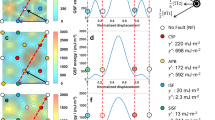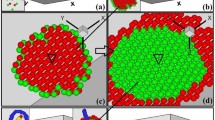Abstract
We performed molecular dynamics simulations to evaluate the effects of stacking fault energy (SFE) on interactions between a screw dislocation and spherical voids in face-centered cubic (fcc) metals. It was observed that the frequency of the cross-slips is a critical factor affecting the interaction, with primarily three different interaction morphologies being observed: (1) the two partial dislocations detach from the void independently with a time lag, (2) the two partial dislocations detach from the void almost simultaneously on a single slip plane, and (3) the two partial dislocations detach from the void almost simultaneously while involving more than one cross-slip and a jog formation. The magnitude of the critical resolved shear stress (CRSS) increases in the order mentioned above. The CRSS values for interaction morphology (2), which was observed most frequently in this study, were in good agreement with those predicted analytically by adjusting the parameters dependent on the SFE. Based on the obtained results, we discussed the applicability of the analytical model for void hardening in fcc metals. The results of this work contribute significantly to the modeling of mechanical property degradation in irradiated metals.





















Similar content being viewed by others
References
Osetsky YN, Bacon DJ (2003) Void and precipitate strengthening in α-iron: what can we learn from atomic-level modelling? J Nucl Mater 323:268–280
Hatano T, Matsui H (2005) Molecular dynamics investigation of dislocation pinning by a nanovoid in copper. Phys Rev B 72:094105–1–094105–8
Hatano T, Kaneko T, Abe Y, Matsui H (2008) Void-induced cross slip of screw dislocations in fcc copper. Phys Rev B 77:064108–1–064108–6
Osetsky YN, Bacon DJ (2010) Atomic-scale mechanisms of void hardening in bcc and fcc metals. Philos Mag 90:945–961
Hatano T (2006) Dynamics of a dislocation bypassing an impenetrable precipitate: the Hirsch mechanism revisited. Phys Rev B 74:020102–1–020102–4
Wirth BD, Bulatov VV, Diaz de la Rubia T (2002) Dislocation-stacking fault tetrahedron interactions in Cu. J Eng Mater Technol 124:329–334
Osetsky YN, Rodney D, Bacon DJ (2006) Atomic-scale study of dislocation–stacking fault tetrahedron interactions. Part I Mech Philos Mag 86:2295–2313
Rodney D, Martin G (2000) Dislocation pinning by glissile interstitial loops in a nickel crystal: a molecular-dynamics study. Phys Rev B 61:8714–8725
Nogaret T, Robertson C, Rodney D (2007) Atomic-scale plasticity in the presence of Frank loops. Philos Mag 87:945–966
Terentrev D, Bakaev A, Osetsky YN (2013) Interaction of dislocations with Frank loops in Fe-Ni alloys and pure Ni: an MD study. J Nucl Mater 442:S628–S632
Hayakawa S, Hayashi Y, Okita T, Itakura M, Suzuki K, Kuriyama Y (2016) Effects of stacking fault energies on the interaction between an edge dislocation and an 8.0-nm-diameter Frank loop of self-interstitial atoms. Nucl Mater Energy 9:581–586
Bampton CC, Jones IP, Loretto MH (1978) Stacking fault energy measurements in some austenitic stainless steels. Acta Metall 26:39–51
Cockayne DJH, Jenkins ML, Ray ILF (1971) The measurement of stacking-fault energies of pure face-centred cubic metals. Philos Mag 24:1383–1392
Haasen P (1958) Plastic deformation of nickel single crystals at low temperatures. Philos Mag 3:384–418
Fullman R (1951) Interfacial free energy of coherent twin boundaries in copper. J Appl Phys 22:448–455
Hull D, Bacon DJ (1984) Introduction to dislocations, 3rd edn. Pergamon, Oxford
Asari K, Hetland OS, Fujita S, Itakura M, Okita T (2013) The effect of stacking fault energy on interactions between an edge dislocation and a spherical void by molecular dynamics simulations. J Nucl Mater 442:360–364
Okita T, Asari K, Fujita S, Itakura M (2014) Effect of the stacking fault energy on interactions between an edge dislocation and a spherical void in FCC metals at various spatial geometries. Fusion Sci Technol 66:289–294
Doihara K, Okita T, Itakura M, Aichi M, Suzuki K (2018) Atomic simulations to evaluate effects of stacking fault energy on interactions between edge dislocation and spherical void in face-centered cubic metals. Philos Mag 98:2061–2076
Garner FA (2010) Void swelling and irritation creep in light water reactor (LWR) environments. In: Tipping PG (ed) Understanding and mitigating ageing in nuclear power plants, 1st edn. Woodhead Publishing, Cambridge, pp 308–356
Huang Y, Wiezorek JMK, Garner FA, Freyer PD, Okita T, Sagisaka M, Isobe Y, Allen TR (2015) Microstructural characterization and density change of 304 stainless steel reflector blocks after long-term irradiation in EBR-II. J Nucl Mater 465:516–530
Lucas GE (1993) The evolution of mechanical property change in irradiated austenitic stainless steels. J Nucl Mater 206:287–305
Tan L, Busby JT (2015) Formulating the strength factor α for improved predictability of radiation hardening. J Nucl Mater 465:724–730
LAMMPS Molecular Dynamics Simulator, http://lammps.sandia.gov/. Accessed 22 Jan 2019
Borovikov V, Mendelev MI, King AH, LeSar R (2015) Effect of stacking fault energy on mechanism of plastic deformation in nanotwinned FCC metals. Model Simul Mater Sci Eng 23:055003–1–055003–16
Mendelev MI, Kramer MJ, Becker CA, Asta M (2008) Analysis of semi-empirical interatomic potentials appropriate for simulation of crystalline and liquid Al and Cu. Philos Mag 88:1723–1750
Rodney D (2004) Molecular dynamics simulation of screw dislocations interacting with interstitial frank loops in a model FCC crystal. Acta Mater 52:607–614
Tsuzuki H, Branicio PS, Rino JP (2007) Structural characterization of deformed crystals by analysis of common atomic neighbourhood. Comput Phys Commun 177:518–523
Li J (2003) AtomEye: an efficient atomistic configuration viewer. Model Simul Mater Sci Eng 11:173–177
Rasmussen T, Jacobsen KW, Leffers T, Pedersen OB (1997) Simulations of the atomic structure, energetics, and cross slip of screw dislocations in copper. Phys Rev B 56:2977–2990
Bacon DJ, Kocks UF, Scattergood RO (1973) The effect of dislocation self-interaction on the Orowan stress. Philos Mag 28:1241–1263
Proville L, Bako B (2010) Dislocation depinning from ordered nanophases in a model fcc crystal: from cutting mechanism to Orowan looping. Acta Mater 58:5565–5571
Deres J, Proville L, Marinica MC (2015) Dislocation depinning from nano-sized irradiation defects in a bcc iron model. Acta Mater 99:99–105
Hirth JP, Lothe J (1982) Theory of dislocations. McGraw-Hill, New York
Rassoulinejad-Mousavi SM, Mao Y, Zhang Y (2016) Evaluation of copper, aluminum, and nickel interatomic potentials on predicting the elastic properties. J Appl Phys 119:244304–1–244304–14
Osetsky YN, Bacon DJ, Serra A, Singh BN (2001) Interactions between edge dislocations and interstitial clusters in iron and copper. In: Materials Research Society Symposium-Proceedings, vol 653, p Z3.4
Osetsky YN, Bacon DJ (2003) An atomic-level model for studying the dynamics of edge dislocations in metals. ModelSimul Mater Sci Eng 11:427–446
Acknowledgements
This work was supported by JSPS KAKENHI Grant Numbers JP17H03518, JP17KT0039 and JP18J12324. The computation was carried out using the computer resource offered under the category of General Projects by the Research Institute for Information Technology, Kyushu University.
Author information
Authors and Affiliations
Corresponding author
Additional information
Publisher's Note
Springer Nature remains neutral with regard to jurisdictional claims in published maps and institutional affiliations.
Rights and permissions
About this article
Cite this article
Hayakawa, S., Doihara, K., Okita, T. et al. Screw dislocation–spherical void interactions in fcc metals and their dependence on stacking fault energy. J Mater Sci 54, 11509–11525 (2019). https://doi.org/10.1007/s10853-019-03716-0
Received:
Accepted:
Published:
Issue Date:
DOI: https://doi.org/10.1007/s10853-019-03716-0




